| Weight | 1 lbs |
|---|---|
| Dimensions | 9 × 5 × 2 in |
| host | mouse |
| isotype | IgG3 |
| clonality | monoclonal |
| concentration | 1 mg/mL |
| applications | ICC/IF, WB |
| reactivity | Transglutaminase-2 (TG2) |
| available sizes | 100 µg |
mouse anti-Transglutaminase-2 (TG2) monoclonal antibody (7D2) 4432
$520.00
Antibody summary
- Mouse monoclonal to Transglutaminase-2 (TG2)
- Suitable for: WB,ICC
- Isotype: IgG3
- 100 µg
mouse anti-Transglutaminase-2 (TG2) monoclonal antibody (7D2) 4432
| antibody |
|---|
| Tested applications WB,ICC/IF |
| Recommended dilutions Immunoblotting: use at 1-5ug/mL. A band of ~80kDa is detected. Immunocytochemistry: use at 2- 10ug/mL. These are recommended concentrations. Enduser should determine optimal concentrations for their applications. |
| Immunogen Purified TG2 from guinea pig liver (accession no. P21980). |
| Size and concentration 100µg and |
| Form lyophilized |
| Storage Instructions This product is stable for at least one (1) year at -20°C to -70°C. Reconstituted product should be stored in appropriate aliquots to avoid repeated freeze-thaw cycles. |
| Storage buffer Lyophilized, 0.1M Tris, 0.1M glycine, 2% sucrose |
| Purity protein affinity purification |
| Clonality monoclonal |
| Isotype IgG3 |
| Compatible secondaries goat anti-mouse IgG, H&L chain specific, peroxidase conjugated polyclonal antibody 5486 goat anti-mouse IgG, H&L chain specific, biotin conjugated, Conjugate polyclonal antibody 2685 goat anti-mouse IgG, H&L chain specific, FITC conjugated polyclonal antibody 7854 goat anti-mouse IgG, H&L chain specific, peroxidase conjugated polyclonal antibody, crossabsorbed 1706 goat anti-mouse IgG, H&L chain specific, biotin conjugated polyclonal antibody, crossabsorbed 1716 goat anti-mouse IgG, H&L chain specific, FITC conjugated polyclonal antibody, crossabsorbed 1721 |
| Isotype control Mouse monocolonal IgG3 - Isotype Control |
| target relevance |
|---|
| Protein names Protein-glutamine gamma-glutamyltransferase 2 (EC 2.3.2.13) (Erythrocyte transglutaminase) (Heart G alpha(h)) (hhG alpha(h)) (Isopeptidase TGM2) (EC 3.4.-.-) (Protein G alpha(h)) (G(h)) (Protein-glutamine deamidase TGM2) (EC 3.5.1.44) (Protein-glutamine dopaminyltransferase TGM2) (EC 2.3.1.-) (Protein-glutamine histaminyltransferase TGM2) (EC 2.3.1.-) (Protein-glutamine noradrenalinyltransferase TGM2) (EC 2.3.1.-) (Protein-glutamine serotonyltransferase TGM2) (EC 2.3.1.-) (Tissue transglutaminase) (tTG) (tTgase) (Transglutaminase C) (TG(C)) (TGC) (TGase C) (Transglutaminase H) (TGase H) (Transglutaminase II) (TGase II) (Transglutaminase-2) (TG2) (TGase-2) (hTG2) |
| Gene names TGM2,TGM2 |
| Protein family Transglutaminase superfamily, Transglutaminase family |
| Mass 77329Da |
| Function FUNCTION: Calcium-dependent acyltransferase that catalyzes the formation of covalent bonds between peptide-bound glutamine and various primary amines, such as gamma-amino group of peptide-bound lysine, or mono- and polyamines, thereby producing cross-linked or aminated proteins, respectively (PubMed:23941696, PubMed:31991788, PubMed:9252372). Involved in many biological processes, such as bone development, angiogenesis, wound healing, cellular differentiation, chromatin modification and apoptosis (PubMed:1683874, PubMed:27270573, PubMed:28198360, PubMed:7935379, PubMed:9252372). Acts as a protein-glutamine gamma-glutamyltransferase by mediating the cross-linking of proteins, such as ACO2, HSPB6, FN1, HMGB1, RAP1GDS1, SLC25A4/ANT1, SPP1 and WDR54 (PubMed:23941696, PubMed:24349085, PubMed:29618516, PubMed:30458214). Under physiological conditions, the protein cross-linking activity is inhibited by GTP; inhibition is relieved by Ca(2+) in response to various stresses (PubMed:18092889, PubMed:7592956, PubMed:7649299). When secreted, catalyzes cross-linking of proteins of the extracellular matrix, such as FN1 and SPP1 resulting in the formation of scaffolds (PubMed:12506096). Plays a key role during apoptosis, both by (1) promoting the cross-linking of cytoskeletal proteins resulting in condensation of the cytoplasm, and by (2) mediating cross-linking proteins of the extracellular matrix, resulting in the irreversible formation of scaffolds that stabilize the integrity of the dying cells before their clearance by phagocytosis, thereby preventing the leakage of harmful intracellular components (PubMed:7935379, PubMed:9252372). In addition to protein cross-linking, can use different monoamine substrates to catalyze a vast array of protein post-translational modifications: mediates aminylation of serotonin, dopamine, noradrenaline or histamine into glutamine residues of target proteins to generate protein serotonylation, dopaminylation, noradrenalinylation or histaminylation, respectively (PubMed:23797785, PubMed:30867594). Mediates protein serotonylation of small GTPases during activation and aggregation of platelets, leading to constitutive activation of these GTPases (By similarity). Plays a key role in chromatin organization by mediating serotonylation and dopaminylation of histone H3 (PubMed:30867594, PubMed:32273471). Catalyzes serotonylation of 'Gln-5' of histone H3 (H3Q5ser) during serotonergic neuron differentiation, thereby facilitating transcription (PubMed:30867594). Acts as a mediator of neurotransmission-independent role of nuclear dopamine in ventral tegmental area (VTA) neurons: catalyzes dopaminylation of 'Gln-5' of histone H3 (H3Q5dop), thereby regulating relapse-related transcriptional plasticity in the reward system (PubMed:32273471). Regulates vein remodeling by mediating serotonylation and subsequent inactivation of ATP2A2/SERCA2 (By similarity). Also acts as a protein deamidase by mediating the side chain deamidation of specific glutamine residues of proteins to glutamate (PubMed:20547769, PubMed:9623982). Catalyzes specific deamidation of protein gliadin, a component of wheat gluten in the diet (PubMed:9623982). May also act as an isopeptidase cleaving the previously formed cross-links (PubMed:26250429, PubMed:27131890). Also able to participate in signaling pathways independently of its acyltransferase activity: acts as a signal transducer in alpha-1 adrenergic receptor-mediated stimulation of phospholipase C-delta (PLCD) activity and is required for coupling alpha-1 adrenergic agonists to the stimulation of phosphoinositide lipid metabolism (PubMed:8943303). {ECO:0000250|UniProtKB:P08587, ECO:0000250|UniProtKB:P21981, ECO:0000269|PubMed:12506096, ECO:0000269|PubMed:1683874, ECO:0000269|PubMed:18092889, ECO:0000269|PubMed:20547769, ECO:0000269|PubMed:23797785, ECO:0000269|PubMed:23941696, ECO:0000269|PubMed:24349085, ECO:0000269|PubMed:26250429, ECO:0000269|PubMed:27131890, ECO:0000269|PubMed:28198360, ECO:0000269|PubMed:29618516, ECO:0000269|PubMed:30458214, ECO:0000269|PubMed:30867594, ECO:0000269|PubMed:31991788, ECO:0000269|PubMed:32273471, ECO:0000269|PubMed:7592956, ECO:0000269|PubMed:7649299, ECO:0000269|PubMed:7935379, ECO:0000269|PubMed:8943303, ECO:0000269|PubMed:9252372, ECO:0000269|PubMed:9623982, ECO:0000303|PubMed:27270573}.; FUNCTION: [Isoform 2]: Has cytotoxic activity: is able to induce apoptosis independently of its acyltransferase activity. {ECO:0000269|PubMed:17116873}. |
| Catalytic activity CATALYTIC ACTIVITY: Reaction=L-glutaminyl-[protein] + L-lysyl-[protein] = [protein]-L-lysyl-N(6)-5-L-glutamyl-[protein] + NH4(+); Xref=Rhea:RHEA:54816, Rhea:RHEA-COMP:9752, Rhea:RHEA-COMP:10207, Rhea:RHEA-COMP:14005, ChEBI:CHEBI:28938, ChEBI:CHEBI:29969, ChEBI:CHEBI:30011, ChEBI:CHEBI:138370; EC=2.3.2.13; Evidence={ECO:0000255|PROSITE-ProRule:PRU10024, ECO:0000269|PubMed:23941696, ECO:0000269|PubMed:24349085, ECO:0000269|PubMed:31991788}; PhysiologicalDirection=left-to-right; Xref=Rhea:RHEA:54817; Evidence={ECO:0000269|PubMed:23941696, ECO:0000269|PubMed:24349085, ECO:0000269|PubMed:31991788}; CATALYTIC ACTIVITY: Reaction=L-glutaminyl-[protein] + serotonin = 5-serotonyl-L-glutamyl-[protein] + NH4(+); Xref=Rhea:RHEA:66552, Rhea:RHEA-COMP:10207, Rhea:RHEA-COMP:17052, ChEBI:CHEBI:28938, ChEBI:CHEBI:30011, ChEBI:CHEBI:167174, ChEBI:CHEBI:350546; Evidence={ECO:0000269|PubMed:30867594}; PhysiologicalDirection=left-to-right; Xref=Rhea:RHEA:66553; Evidence={ECO:0000269|PubMed:30867594}; CATALYTIC ACTIVITY: Reaction=L-glutaminyl-[protein] + dopamine = 5-dopaminyl-L-glutamyl-[protein] + NH4(+); Xref=Rhea:RHEA:66556, Rhea:RHEA-COMP:10207, Rhea:RHEA-COMP:17053, ChEBI:CHEBI:28938, ChEBI:CHEBI:30011, ChEBI:CHEBI:59905, ChEBI:CHEBI:167175; Evidence={ECO:0000269|PubMed:32273471}; PhysiologicalDirection=left-to-right; Xref=Rhea:RHEA:66557; Evidence={ECO:0000269|PubMed:32273471}; CATALYTIC ACTIVITY: Reaction=L-glutaminyl-[protein] + histamine = 5-histaminyl-L-glutamyl-[protein] + NH4(+); Xref=Rhea:RHEA:66564, Rhea:RHEA-COMP:10207, Rhea:RHEA-COMP:17056, ChEBI:CHEBI:28938, ChEBI:CHEBI:30011, ChEBI:CHEBI:58432, ChEBI:CHEBI:167179; Evidence={ECO:0000269|PubMed:23797785}; PhysiologicalDirection=left-to-right; Xref=Rhea:RHEA:66565; Evidence={ECO:0000269|PubMed:23797785}; CATALYTIC ACTIVITY: Reaction=L-glutaminyl-[protein] + (R)-noradrenaline = 5-(R)-noradrenalinyl-L-glutamyl-[protein] + NH4(+); Xref=Rhea:RHEA:66560, Rhea:RHEA-COMP:10207, Rhea:RHEA-COMP:17054, ChEBI:CHEBI:28938, ChEBI:CHEBI:30011, ChEBI:CHEBI:72587, ChEBI:CHEBI:167178; Evidence={ECO:0000250|UniProtKB:P08587}; PhysiologicalDirection=left-to-right; Xref=Rhea:RHEA:66561; Evidence={ECO:0000250|UniProtKB:P08587}; CATALYTIC ACTIVITY: Reaction=L-glutaminyl-[protein] + H2O = L-glutamyl-[protein] + NH4(+); Xref=Rhea:RHEA:16441, Rhea:RHEA-COMP:10207, Rhea:RHEA-COMP:10208, ChEBI:CHEBI:15377, ChEBI:CHEBI:28938, ChEBI:CHEBI:29973, ChEBI:CHEBI:30011; EC=3.5.1.44; Evidence={ECO:0000269|PubMed:20547769, ECO:0000269|PubMed:9623982}; PhysiologicalDirection=left-to-right; Xref=Rhea:RHEA:16442; Evidence={ECO:0000269|PubMed:20547769, ECO:0000269|PubMed:9623982}; |
| Subellular location SUBCELLULAR LOCATION: Cytoplasm, cytosol {ECO:0000269|PubMed:24349085, ECO:0000269|PubMed:29618516, ECO:0000269|PubMed:9575137}. Nucleus {ECO:0000269|PubMed:29618516, ECO:0000269|PubMed:9575137}. Chromosome {ECO:0000269|PubMed:9575137}. Secreted, extracellular space, extracellular matrix {ECO:0000269|PubMed:12506096, ECO:0000269|PubMed:1683874, ECO:0000269|PubMed:28198360}. Cell membrane {ECO:0000250|UniProtKB:Q9WVJ6}. Mitochondrion {ECO:0000269|PubMed:24349085}. Note=Mainly localizes to the cytosol (PubMed:9575137). Present at much lower level in the nucleus and chromatin (PubMed:9575137). Also secreted via a non-classical secretion pathway to the extracellular matrix (PubMed:27270573). {ECO:0000269|PubMed:9575137, ECO:0000303|PubMed:27270573}.; SUBCELLULAR LOCATION: [Isoform 2]: Cytoplasm, perinuclear region {ECO:0000269|PubMed:17116873}. |
| Structure SUBUNIT: Monomer (PubMed:25192068). Interacts with phospholipase C; promoting alpha-1 adrenergic receptor signaling (PubMed:7592956). Interacts with PLCD1 (By similarity). {ECO:0000250|UniProtKB:Q9WVJ6, ECO:0000269|PubMed:25192068, ECO:0000269|PubMed:7592956}.; SUBUNIT: [Isoform 2]: Homooligomer. {ECO:0000269|PubMed:17116873}. |
| Post-translational modification PTM: Disulfide bond formation inactivates the calcium-dependent acyltransferase activity (PubMed:20547769). Cys-370 can form disulfide bonds with both Cys-230 and Cys-371: formation of a disulfide bond between Cys-230 and Cys-370 facilitates formation of the disulfide between Cys-370 and Cys-371, which promotes inactivation of the acyltransferase activity (PubMed:20547769). May also form interchain disulfids between Cys-230 and Cys-370 (PubMed:25192068). Ca(2+) protects against disulfide bond formation and inactivation (PubMed:20547769). {ECO:0000269|PubMed:20547769, ECO:0000269|PubMed:25192068}.; PTM: Auto-transglutaminated: Forms covalent cross-links mediated by transglutaminase between Gln-633 and the epsilon-amino group of a lysine residue of itself or HMGB1, forming homopolymers and heteropolymers, respectively. {ECO:0000250|UniProtKB:P08587}.; PTM: S-nitrosylated, leading to inactivation of the acyltransferase activity. {ECO:0000250|UniProtKB:P21981}. |
| Involvement in disease DISEASE: Note=TGM2 constitutes the major autoantigen in celiac disease, a multifactorial chronic disorder of the small intestine caused by intolerance to gluten (PubMed:9212111, PubMed:9623982). Celiac disease is characterized by immune-mediated enteropathy associated with failed intestinal absorption and malnutrition: intestinal inflammation is precipitated by ingestion of the protein gliadin, a component of wheat gluten in the diet (PubMed:9212111, PubMed:9623982). TGM2 is the main target for celiac disease-associated anti-endomysium autoantibodies (PubMed:9212111). It mediates its effect by catalyzing specific deamidation of gliadin; this deamidation creates an epitope that binds efficiently to HLA-DQ2 and is recognized by gut-derived T-cells (PubMed:9623982). {ECO:0000269|PubMed:9212111, ECO:0000269|PubMed:9623982}. |
| Target Relevance information above includes information from UniProt accession: P21980 |
| The UniProt Consortium |
Data
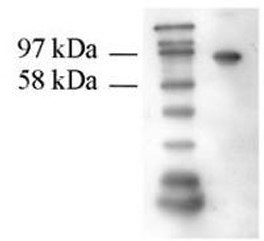 |
| Immunoblotting: use at 1-5ug/ml. A band of ~80kDa is detected. Detection of TG2 in human erythroctyes with #4432. |
Publications
| pmid | title | authors | citation |
|---|---|---|---|
| We haven't added any publications to our database yet. | |||
Protocols
| relevant to this product |
|---|
| Western blot IHC ICC |
Documents
| # | SDS | Certificate | |
|---|---|---|---|
| Please enter your product and batch number here to retrieve product datasheet, SDS, and QC information. | |||
Only logged in customers who have purchased this product may leave a review.
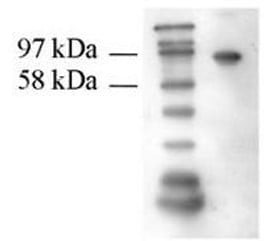
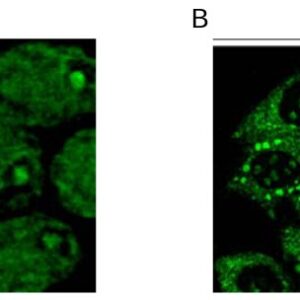

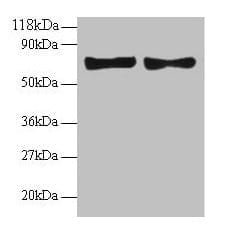
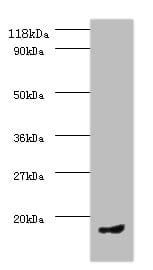

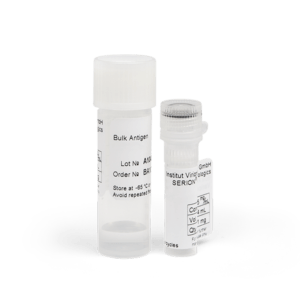

Reviews
There are no reviews yet.